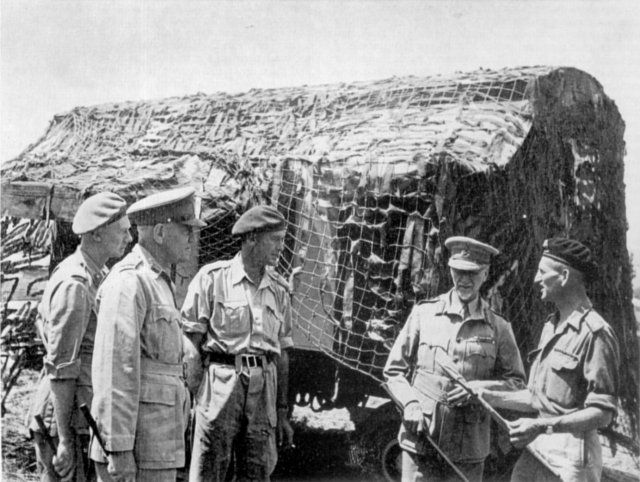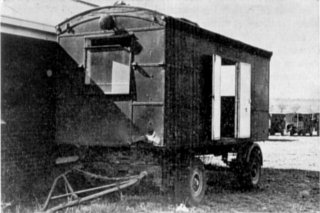

 The South African
The South African
by THE GII
6 Divisional Main Headquarters was a large organization with a plethora of diverse vehicles in its ‘harbour’ area. The derisively-named, ungainly-looking vehicle was an outsize in R.A.F. fourwheeled trailers, probably intended initially for use as a Wing or Group Headquarters. Until recently it stood in the grounds of the S.A. National War Museum in Johannesburg but owing to lack of suitable covered accommodation was presented to the S.A.A.F. Museum, Pretoria. To the amazement of the staff at the desert training camp at Khatatba, this un-engined pantechnicon turned up one dusty Friday to tower above the outline of most of the existing vehicles at headquarters.
The floor of the vehicle was about three feet above the ground and the head. room inside was such that even Brigadier Furstenburg, that giant among brigadiers, could stand up comfortably. At each end were desks with drawers and large windows for adequate lighting by day, whilst all the available wall space was taken up with huge map boards. Excellent electric light facilities and telephone plugs for use in harbour areas were other inside features. Fixed to the roof of the vehicle were huge collapsible canvas verandahs.
The ‘Gin Palace’ immediately became the planning nerve centre of the division’s operations. The A.D.C., Captain Jack Davy, and the Intelligence staff, led by Major Bob Leslie, were responsible for marking up maps — ‘layering’ maps — and procuring large-scale mosaics made from aerial photographs.
Field Marshal Smuts, General Sir Oliver Leese and General Mark Clark were but a few of the distinguished senior officers who had Major-General Poole’s dispositions of troops and plans for future offensives outlined to them in the ‘Gin Palace’ by the G.O.C. himself.

Field Marshal J. C. Smuts visits 6 S.A. Armoured Division.
In the background is 'The Gin Palace'.
The other officers are, fltr:
Maj.-Gen. F.H. Theron, Gen. Sir H.A. (Pierre) van Ryneveld,
Maj.-Gen W.H.E. Poole and Col. E. O'C. Maggs
There was one quiet, sanctified time when, during a few particularly strenuous weeks of mobile operations on the way to Florence, a padre administered Holy Communion in the ‘Gin Palace’ to the General and a few members of the staff at 9 o’clock on a Wednesday evening.
Field Marshal Alexander’s famous desert car was decorated with the Africa Star (subsequently mounted on the mudguard) for its reliability in the desert campaign. For its services to the success of the Sixth S.A. Armoured Division in battle, the ‘Gin Palace’ certainly deserved to be considered for the Italy Star.
Two other important vehicles in the mechanics of command at Main Div. HQ were ACV I (Armoured Command Vehicle No. i) and ACV 8. ACVs were large armour-plated signals vehicles developed in the desert for the staff control of mobile operations. Driven and maintained by Signals personnel, they contained radio sets for forward, lateral and rear communications, had telephones and provided ingeniously designed, if cramped, office accommodation.
ACV I was the operations staff control vehicle and was manned 24 hours a day by the ‘G’ duty officer, even when on the move, a hair-raising experience on some of the narrow switchback roads in the Chianti mountains. ACV 8 performed a similar role for the Divisional Artillery and, when not on the move the two vehicles were in direct line communication as well as through the normal exchange link-up from the signal master’s switchboard.
The final vehicle which should be mentioned was the General’s tank. The first training AFV (Armoured Fighting Vehicle) allotted to General Poole was a Crusader Tank, followed by a converted Grant Tank, which served during most of the Italian campaign, and finally a converted Sherman tank.
The Grant was fitted with a dummy wooden gun from the main turret to help it to ‘try to look like a Sherman’ from a distance. The main armaments were removed to transform the tank into a command tank from which General Poole could operate his tactical headquarters for short spells during particularly heavy fighting.
At this stage of the battle, intercommunication depended largely on wireless, with liaison officers to carry security instructions and to give personal reports to commanders. The command tank was fitted with two wireless sets, one tuned in to the ‘command’ net, and the other often listening on the frequency of the forward units.
As soon as the battle became less fluid, telephone cable was connected to the nearest signals layout. Fixed telephones were provided inside this particular tank for instant use in such circumstances.
The Grant tank was under fire in several engagements, notably on the ii th Armoured Brigade’s first real field day at Celleno onJune 10,1944, (when ‘Pappa’ Brits, with the S.S.B., and Bob Reeves Moore, with the I.L.H./ Kim R., severely mauled the fresh troops of the German 356th Infantry Division), and during the ensuing battle for Bagnoregio.
The officer in command of the General’s Tank Troop was Captain W. Steenkanp, later to be killed while on reconnaissance. Sergeant G. Norton assumed command of the G.O.C.’s tank in the final break-through in April 1945.
At the beginning of each major operation, detailed written operation orders were normally issued by the General Staff (Operations). These conveyed the G.O.C.’s Intentions and ensured that the whole division was ‘in the picture’. These initial orders were subsequently extended or amended, as the operations developed, by verbal or short written orders in signal form, and daily Intentions were usually issued in the evening to cover the following day.
The operational control centre of the division was Main Divisional HQ, in accordance with standard military staff procedure. Being a large and vulnerable organization, communicating whenever possible with brigade HQ, Rear Div. HQ (the Administrative nerve centre of the division) and Corps HQby telephone, Main Div. HQwas moved as infrequently as possible and then in large bounds.
Many successful Generals have fought and led their divisions ‘from the front’ by making use during active operations of a Tactical Headquarters (Tac. Div HQ). General Poole was no exception. In the first few days of the Italian Campaign he took the policy decision of fighting his division from a small highly mobile Tactical Headquarters, often consisting only of one jeep and a motorcycle. In the jeep were the General and the G.S.O. II (Ops) (the writer) and a wireless operator, with a set tuned on two nets. The motor cycle was ridden by the Provost Corporal bodyguard armed with a tommy gun. Usually a liaison officer in a jeep or a scout car accompanied Tac. Div. HQ.
If conditions were expected to warrant it, the General’s command tank and protective troop of tanks would be sent to a rendezvous point, ready to be used at immediate notice, as at Celleno.
Much of 6 S.A. Armoured Division’s success (from a command point of view) can be attributed to the fact that General Poole was always well up with events in his Division, and could take speedy decisions based on face-to-face discussions with his leading brigade commanders. A drawback (not of the employment of a Tac. Div. HQ as such, but of having the most senior G staff officer other than the G.S.O. I as a permanent member) was that, for many of the daylight hours, Main Div. IIQ was deprived of the services of the G.S.O. II (Ops) to whom the G.S.O. I, Colonel Eugene Maggs, with his role of co-ordinating all the arms involved, should have been able to look for ensuring that all the G work was properly done. Fortunately, the G.S.O. III (Ops), Captain Herby Wade, was able to shoulder the extra burden competently.
Had it not been for the respective personalities of General Poole, Colonel Maggs, Major Theunissen and Captain Wade, the more or less permanent daylight split in all weathers of Command HQ into Tac. Div. HQ and Main Div. HQ could have had unhappy consequences. Had the personalities been different, General Poole would perhaps have modified his policy of travelling frequently to the forward areas, though it is a moot point.
As has been inferred, Tac. Div. HQ generally rejoined Main Div. HQ at night. On occasions when this did not occur, considerable strains were placed on the command and control function. The General’s caravan would be sent up to Tac. Div. HQ with the A.D.C. and the protective tank troop, and Signals would have to lay line communication for this small but vital HQ. Messing arrangements would be primitive and G II and A.D.C. would sleep under the canvas lean-to of the caravan. All concerned found these occasions most frustrating, for (living conditions notwithstanding) the General was separated from his Main Staff Advisors and the mechanics of control, such as the ‘Gin Palace’ and ACV I.

'The Gin Palace' (1974) awaiting
restoration and display at
the proposed SAAF Museum
Return to Journal Index OR Society's Home page
South African Military History Society / scribe@samilitaryhistory.org